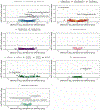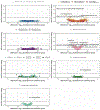Disparities in chemical exposures among pregnant women and neonates by socioeconomic and demographic characteristics: A nontargeted approach
- PMID: 36049512
- PMCID: PMC10016233
- DOI: 10.1016/j.envres.2022.114158
Disparities in chemical exposures among pregnant women and neonates by socioeconomic and demographic characteristics: A nontargeted approach
Abstract
Background: Exposure to environmental chemicals during pregnancy adversely affects maternal and infant health, and identifying socio-demographic differences in exposures can inform contributions to health inequities.
Methods: We recruited 294 demographically diverse pregnant participants in San Francisco from the Mission Bay/Moffit Long (MB/ML) hospitals, which serve a primarily higher income population, and Zuckerberg San Francisco General Hospital (ZSFGH), which serves a lower income population. We collected maternal and cord sera, which we screened for 2420 unique formulas and their isomers using high-resolution mass spectrometry using LC-QTOF/MS. We assessed differences in chemical abundances across socioeconomic and demographic groups using linear regression adjusting for false discovery rate.
Results: Our participants were racially diverse (31% Latinx, 16% Asian/Pacific Islander, 5% Black, 5% other or multi-race, and 43% white). A substantial portion experienced financial strain (28%) and food insecurity (20%) during pregnancy. We observed significant abundance differences in maternal (9 chemicals) and cord sera (39 chemicals) between participants who delivered at the MB/ML hospitals versus ZSFGH. Of the 39 chemical features differentially detected in cord blood, 18 were present in pesticides, one per- or poly-fluoroalkyl substance (PFAS), 21 in plasticizers, 24 in cosmetics, and 17 in pharmaceuticals; 4 chemical features had unknown sources. A chemical feature annotated as 2,4-dichlorophenol had higher abundances among Latinx compared to white participants, those delivering at ZSFGH compared to MB/ML, those with food insecurity, and those with financial strain. Post-hoc QTOF analyses indicated the chemical feature was either 2,4-dichlorophenol or 2,5-dichlorophenol, both of which have potential endocrine-disrupting effects.
Conclusions: Chemical exposures differed between delivery hospitals, likely due to underlying social conditions faced by populations served. Differential exposures to 2,4-dichlorophenol or 2,5-dichlorophenol may contribute to disparities in adverse outcomes.
Copyright © 2022. Published by Elsevier Inc.
Conflict of interest statement
Declaration of competing interest The authors declare that they have no known competing financial interests or personal relationships that could have appeared to influence the work reported in this paper.
Figures






Similar articles
-
Investigating geographic differences in environmental chemical exposures in maternal and cord sera using non-targeted screening and silicone wristbands in California.J Expo Sci Environ Epidemiol. 2023 Jul;33(4):548-557. doi: 10.1038/s41370-022-00426-9. Epub 2022 Apr 21. J Expo Sci Environ Epidemiol. 2023. PMID: 35449448 Free PMC article.
-
A Suspect Screening Method for Characterizing Multiple Chemical Exposures among a Demographically Diverse Population of Pregnant Women in San Francisco.Environ Health Perspect. 2018 Jul 24;126(7):077009. doi: 10.1289/EHP2920. eCollection 2018 Jul. Environ Health Perspect. 2018. PMID: 30044231 Free PMC article.
-
Concentrations of persistent organic pollutants in maternal and cord blood from the maternal-infant research on environmental chemicals (MIREC) cohort study.Environ Health. 2016 May 4;15(1):59. doi: 10.1186/s12940-016-0143-y. Environ Health. 2016. PMID: 27142700 Free PMC article.
-
Cumulative Chemical Exposures During Pregnancy and Early Development.Curr Environ Health Rep. 2015 Dec;2(4):367-78. doi: 10.1007/s40572-015-0064-x. Curr Environ Health Rep. 2015. PMID: 26341623 Free PMC article. Review.
-
Disparities in Environmental Exposures to Endocrine-Disrupting Chemicals and Diabetes Risk in Vulnerable Populations.Diabetes Care. 2018 Jan;41(1):193-205. doi: 10.2337/dc16-2765. Epub 2017 Nov 15. Diabetes Care. 2018. PMID: 29142003 Free PMC article. Review.
Cited by
-
Reduced bioenergetics and mitochondrial fragmentation in human primary cytotrophoblasts induced by an EGFR-targeting chemical mixture.Chemosphere. 2024 Sep;364:143301. doi: 10.1016/j.chemosphere.2024.143301. Epub 2024 Sep 7. Chemosphere. 2024. PMID: 39251161
-
The Impact of Endocrine Disruptors on the Female Genital Tract Microbiome: A Narrative Review.Life (Basel). 2025 Jul 24;15(8):1177. doi: 10.3390/life15081177. Life (Basel). 2025. PMID: 40868824 Free PMC article. Review.
-
Prenatal exposures to endocrine disrupting chemicals: The role of multi-omics in understanding toxicity.Mol Cell Endocrinol. 2023 Dec 1;578:112046. doi: 10.1016/j.mce.2023.112046. Epub 2023 Aug 19. Mol Cell Endocrinol. 2023. PMID: 37598796 Free PMC article. Review.
-
Extending Nontargeted Discovery of Environmental Chemical Exposures during Pregnancy and Their Association with Pregnancy Complications-A Cross-Sectional Study.Environ Health Perspect. 2023 Jul;131(7):77003. doi: 10.1289/EHP11546. Epub 2023 Jul 19. Environ Health Perspect. 2023. PMID: 37466315 Free PMC article.
-
Determinants of maternal and neonatal PFAS concentrations: a review.Environ Health. 2023 May 10;22(1):41. doi: 10.1186/s12940-023-00992-x. Environ Health. 2023. PMID: 37161484 Free PMC article.
References
-
- Sapbamrer R, Hongsibsong S. Effects of prenatal and postnatal exposure to organophosphate pesticides on child neurodevelopment in different age groups: a systematic review. Environmental Science and Pollution Research. 2019;26(18):18267–90. - PubMed
-
- Ejaredar M, Nyanza EC, Ten Eycke K, Dewey D. Phthalate exposure and childrens neurodevelopment: a systematic review. Environmental research. 2015;142:51–60. - PubMed

